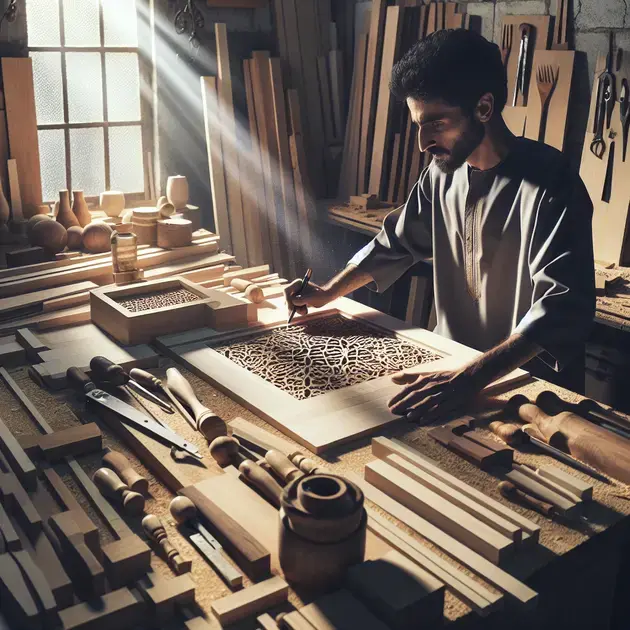Woodworking is a fascinating craft that allows beginners to unleash their creativity and build impressive projects from scratch. In this ultimate guide, we will share expert tips and tricks to help you elevate your woodworking skills to the next level.
One of the most important aspects of woodworking is selecting the right type of wood for your projects. Beginners often struggle with this decision, but fear not – our guide will provide you with valuable insights on choosing the perfect wood for each project, ensuring that your creations are not only beautiful but also durable and long-lasting.

Choosing the Right Type of Wood for Your Projects
Choosing the right type of wood for your woodworking projects is crucial for achieving the desired results. Start by considering the characteristics of different wood species, such as hardness, grain pattern, and color. Websites like Wood Database provide comprehensive information on various wood types, helping you make an informed decision.
Next, think about the project requirements. For furniture making, hardwoods like oak or mahogany are often preferred for their durability and aesthetic appeal. Softwoods like pine or cedar, on the other hand, are great for outdoor projects due to their resistance to decay.
Visit local lumberyards or woodworking stores to physically inspect the wood before purchasing. Look for straight, free of knots, and well-dried boards to prevent warping or cracking during the project. Additionally, consider the environmental impact by choosing sustainably sourced wood options.
Finally, don’t forget to account for your own woodworking skills and tools. Some wood species are easier to work with than others, so choose a type that aligns with your experience level. By following these steps and doing thorough research, you can confidently select the right wood for your projects.
Mastering Essential Woodworking Tools
Mastering essential woodworking tools is key to efficiently and accurately completing your projects. Begin by familiarizing yourself with basic tools like a saw, chisel, and hammer. Online platforms such as Fine Woodworking offer tutorials and guides on how to use these tools effectively.
Practice proper tool maintenance to ensure longevity and optimal performance. Regularly sharpening saw blades and keeping hand tools clean and rust-free will improve their functionality and results. Consider investing in high-quality tools that will last a lifetime.
Learn various woodworking techniques, such as joinery and routing, to expand your skill set. Attend workshops or online classes from sites like Udemy to enhance your knowledge and proficiency with different tools.
Experiment with different projects that require the use of specific tools. Build a small wooden box to practice sawing and chiseling, or construct a picture frame to perfect miter joints. The more you practice and explore with your tools, the more mastery you will achieve.
Enhancing Your Woodworking Skills with Advanced Techniques
Enhancing your woodworking skills with advanced techniques opens up a world of creative possibilities. Start by mastering complex joinery methods like dovetail or mortise and tenon joints. Websites like Popular Woodworking offer step-by-step tutorials on these techniques.
Explore the world of wood carving and sculpting to add intricate details and designs to your projects. Sites like Woodcarving Illustrated provide patterns and instructions for carving different wood species.
Experiment with wood bending techniques using steam or laminating to create unique shapes and forms. Online communities like Woodweb offer forums where you can learn from experienced woodworkers and share your own experiences.
Consider incorporating mixed materials like metal or glass into your woodworking projects for a modern twist. Learn how to safely and effectively combine different materials by following tutorials from Instructables and other DIY platforms.

**Building a Strong Foundation: Woodworking Basics for Beginners**
Introduction
Woodworking is a rewarding and fulfilling hobby that allows individuals to create beautiful and functional pieces from wood. For beginners, understanding the basics of woodworking is essential to build a strong foundation for future projects. By mastering fundamental skills and techniques, beginners can progress to more complex woodworking endeavors with confidence and precision.
Getting Started with Tools
One of the first steps in woodworking is familiarizing yourself with the essential tools required for various tasks. These tools include saws, drills, hammers, measuring tape, and sandpaper, among others. Investing in high-quality tools is crucial to ensuring precision and efficiency in your woodworking projects.
Understanding Wood Types and Cuts
Wood comes in a variety of types, each with unique characteristics and uses. Beginners should familiarize themselves with common wood types such as pine, oak, and maple, as well as different cuts like cross-cut, rip-cut, and miter cut. Understanding the properties of different wood types and cuts will help beginners choose the right materials for their projects.
Learning Basic Joinery Techniques
Joinery is the process of connecting two pieces of wood together to create a sturdy and durable structure. Beginners should start by mastering basic joinery techniques such as butt joints, dado joints, and lap joints. These techniques form the foundation for more advanced joinery methods and designs.
Practicing Safety Measures
Safety should always be a top priority in woodworking to prevent accidents and injuries. Beginners should familiarize themselves with safety practices such as wearing protective gear, using tools properly, and maintaining a clean and organized workspace. By prioritizing safety, woodworkers can enjoy their craft without compromising their well-being.
**Unlocking Creativity: Design Tips for Your Woodworking Projects**
Exploring Inspiration Sources
Great woodworking projects often start with inspiration from various sources. Beginners can find creative ideas for their projects by exploring woodworking magazines, online forums, and social media platforms dedicated to woodworking. Drawing inspiration from different sources can help unlock creativity and spark new ideas for unique designs.
Experimenting with Different Styles
Woodworking allows for endless possibilities in terms of styles and designs. Beginners can unleash their creativity by experimenting with different woodworking styles such as traditional, modern, rustic, and minimalist. Trying out new styles and techniques can help woodworkers discover their preferred aesthetic and develop a signature design aesthetic.
Incorporating Personal Touches
Adding personal touches to woodworking projects can make them truly one-of-a-kind. Beginners can incorporate meaningful elements such as personalized engravings, unique finishes, or special woodworking techniques that reflect their personality and style. By infusing projects with personal touches, woodworkers can create pieces that hold sentimental value and showcase their craftsmanship.
Seeking Feedback and Collaboration
Feedback from peers and experienced woodworkers can provide valuable insights and suggestions for improving design concepts. Beginners can seek feedback from woodworking communities, attend workshops, or collaborate with other woodworkers to exchange ideas and techniques. Engaging with others in the woodworking community can inspire new design approaches and enhance creative processes.
Embracing Iteration and Evolution
Creativity in woodworking is an iterative process that involves continuous refinement and evolution of design ideas. Beginners should embrace the concept of iteration, where projects undergo multiple revisions and adjustments to achieve the desired outcome. By being open to evolution and learning from each project, woodworkers can unlock their creativity and achieve new levels of design excellence.
**Troubleshooting Common Woodworking Mistakes**
Identifying Measurement Errors
One common woodworking mistake is inaccurate measurements, which can lead to misaligned pieces and flawed constructions. Beginners should double-check measurements using a reliable measuring tool and ensure precision in cutting and assembly. By paying close attention to measurements, woodworkers can avoid costly mistakes and achieve accurate results in their projects.
Addressing Wood Splintering
Wood splintering can occur during cutting or shaping processes, resulting in rough or damaged edges on the wood. Beginners can prevent splintering by using sharp blades and cutting tools, as well as applying masking tape or scoring the cutting line beforehand. Addressing wood splintering promptly can help maintain the quality and aesthetics of woodworking projects.
Dealing with Glue and Adhesive Issues
Improper application of glue or adhesive can weaken joints and compromise the structural integrity of woodworking projects. Beginners should follow manufacturer instructions for using adhesives, apply an even layer of glue, and ensure proper clamping pressure during bonding. By addressing glue and adhesive issues correctly, woodworkers can create durable and long-lasting woodwork pieces.
Resolving Finishing Problems
Finishing is a critical stage in woodworking that enhances the appearance and durability of projects. Common finishing problems such as uneven staining, blotchy finishes, or streaky varnishes can detract from the overall quality of woodworking pieces. Beginners should practice proper finishing techniques, such as sanding between coats, using compatible finishes, and applying even layers for a flawless finish.
Learning from Mistakes and Improving Skills
Woodworking mistakes are valuable learning opportunities that can help beginners grow and improve their skills. Instead of becoming discouraged by errors, woodworkers should analyze mistakes, identify root causes, and implement corrective measures to prevent them in future projects. By learning from mistakes and continuously improving skills, woodworkers can enhance their craftsmanship and achieve greater mastery in woodworking.
Conclusion
In conclusion, mastering the woodworking basics is crucial for beginners to establish a solid foundation and progress confidently in their projects. By understanding essential tools, wood types, cuts, and basic joinery techniques, beginners can ensure precision and efficiency in their work. Safety measures should always be prioritized to enjoy woodworking without risking well-being.
Unlocking creativity in woodworking involves exploring various inspiration sources, experimenting with different styles, incorporating personal touches, seeking feedback and collaboration, and embracing iteration for design evolution. These practices help woodworkers unleash their creativity, develop a unique aesthetic, and enhance their design excellence.
Additionally, troubleshooting common woodworking mistakes like measurement errors, wood splintering, glue and adhesive issues, and finishing problems is necessary for improving skills. Learning from mistakes, analyzing root causes, and implementing corrective measures enable woodworkers to grow, enhance their craftsmanship, and achieve mastery in woodworking over time.